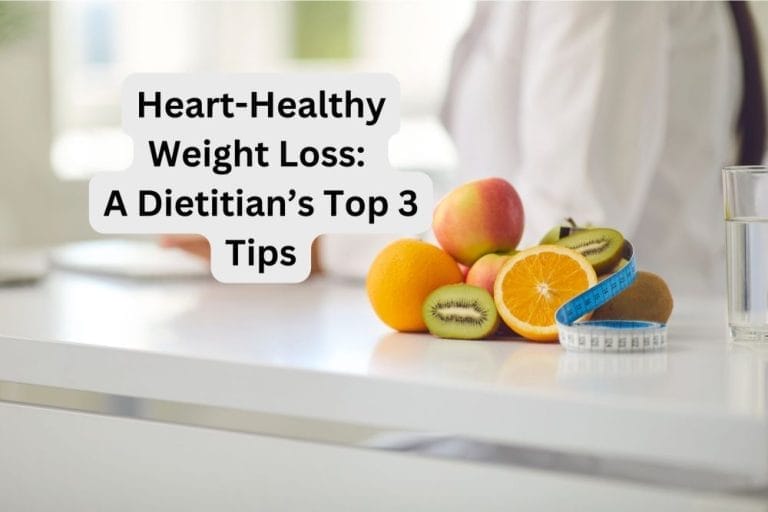Eating At Home vs Eating Out: Which Is Better for Your Heart?
This post may contain affiliate links, which means I’ll receive a commission if you purchase through my links, at no extra cost to you. Please read my full disclosure for more information.
If you’ve been trying to learn more about heart health and how to manage your food choices, you may have come across the topic of home-cooked versus restaurant meals and the pros and cons of each. You may be wondering, is a meal really better if you make it at home? Or are the differences over exaggerated?
You may be concerned that eating out could completely wreck your chances of eating in a heart-healthy way; however, that doesn’t have to be the case. In this post we’ll take a deeper dive into several considerations in the eating at home versus eating out debate, along with suggestions to try both in restaurants and at home.
Quick disclaimer—although I am a registered dietitian nutritionist, your reading of this or any articles on this website does not constitute medical nutrition therapy advice nor create a practitioner-client relationship. The information I provide here on this website is for educational and informational purposes only. Please see my full disclaimer for more information.
Let’s get started!
Portion Control
Part of keeping your heart healthy is to manage your weight by making wise food choices in appropriate amounts. This is the principle of portion control. Let’s discuss some of the potential portion-related differences in home-cooked meals versus restaurant meals.
First, as is probably well known, restaurant (or takeout) foods are usually served in larger amounts than the amount you would cook and eat at home. At times, it may be easier to tell when a restaurant food portion size is larger than what you might eat at home. At other times it isn’t—you may be distracted, or the lighting inside the restaurant may be dimmer so that you aren’t as able to assess the amount of food served to you.
Second, it may be more difficult to eat an appropriate serving size of the restaurant food because of what else is going on inside the restaurant. You may be having a stimulating conversation with someone or watching the tv screen on the wall. Before you know it, you’ve eaten more than you had planned.
I will admit, it is definitely possible to become distracted at home as well. However, you will often have more control over the distractions at home. In a restaurant, you are probably not able to change the entertainment, music, or lighting; you won’t really have control over the volume of conversation or other activities occurring.
Third, there are times when you may feel compelled to eat all of your meal at a restaurant, such as at a buffet or at a more upscale restaurant that offers a several-course meal with a no-leftovers policy. In these cases, it may be far more challenging to avoid eating more than you would prefer. When you eat at home, you will usually have the option to put your leftovers in the fridge for another day.
While I’m not saying that all restaurant eating will ruin your ability to manage your portion sizes, it does follow that cooking at home presents greater opportunities to control those portions. It is also true that takeout can present an opportunity to control your portion sizes more when you eat it at home—you can manage how much you serve yourself. Keep these thoughts in mind as you decide where and how you will be eating your meals.
Sodium Intake
A second major consideration in the challenge between eating at home and eating out is the sodium content of both individual foods and meals. When you make your food at home, you have control over the amount of sodium that goes into it. At a restaurant, you may not have as much (or any) control.
There certainly are ways to lessen the sodium content of restaurant meals you may eat. For example, you can look at nutrition facts information on a chain restaurant’s website or ask your server to inform the kitchen to use less salt. You can also choose the simplest items on the menu to avoid the extra sodium that comes with dressings, sauces, gravies, and breading.
It is also possible to consume more sodium when at home because of what you buy at the store. Many packaged or prepared foods such as flavored rice or some frozen meals do have a fairly high amount of sodium. It pays to read the labels closely to ensure you are buying lower sodium options.
Having explored several realities regarding sodium content of meals from a restaurant versus those made at home, I believe we can draw the conclusion that in both situations, it is possible to moderate your sodium intake. However, it may be more difficult to do so in the context of eating out.
Types of Fats Used
A third important factor in the home versus restaurant debate is that of the fat sources in your food. While you can certainly find heart-healthy fats like avocados and olive oil at some restaurants, not all restaurants will be able to use healthier fat sources when they prepare your meal.
When foods are fried in the deep fryer, the oil used for frying can start to produce byproducts that are not very good for our bodies and our hearts.1 And although you may ask for a grilled item or a plain burger, the cook may be using some kind of an industrial oil to coat the cooking surface during the preparation of your food.
The topic of certain types of oils and their health benefits and risks has been controversial; right now it is not my intent to get into that debate. But I will offer this thought: the occasional meal out will not ruin your heart health. However, if eating out is a frequent part of your life, you may have a greater chance of consuming not as healthy oils.
Therefore, knowing the types of fats used at home versus at a restaurant, it may be more of an advantage for you to prepare meals at home. That way you’re in control of the fats that are going into your food.
Costs Involved
A fourth main point in our discussion is the costs involved when it comes to eating at home versus eating out. Disclaimer: I am not a financial expert and have not created detailed cost comparisons. And in truth, there are perhaps times when certain meals out may actually be cheaper than preparing a dish at home.
But for a majority of situations, eating out may end up costing you more in the long run. Part of that is because when you buy food from a restaurant, you are also paying for labor in preparing the food and the service of getting it to you (like waitstaff). And restaurants wouldn’t continue to exist without being able to make a profit; so food cost needs to be marked up for them to do so.
This topic wouldn’t be complete without adding that some meal preparation kits or pre-made meals you can find in the store may still be more expensive than creating a meal from scratch in your kitchen. However, most of the time they usually cost less than buying the same type of food at a restaurant.
To wrap up this section, if you were to track your spending on restaurant meals versus those you prepare at home, you may well find that you end up spending more money on eating out than on eating at home. Ultimately, it is up to you to decide how you wish to spend your money; but I would encourage careful consideration of eating more at home due to the other benefits it can provide you.
Time
Our last main point is that of time. While grabbing takeout or dashing into a restaurant for a quick meal may sound time-saving, it may not necessarily have a consistently clear advantage over cooking at home.
Think about this first—how much time are you spending driving to the restaurant or waiting in line inside or in the drive-thru? Depending on where you live, the nearest restaurant may actually not be so near, and the time you spend waiting for your food can add up quickly.
The argument for heading to a restaurant is that home cooked meals may take a time commitment that not many of us have these days. And that is true, especially if you’re preparing a more elaborate meal or recipe. And yes, some recipes do take quite a bit of time.
But there are ways to streamline things when you’re cooking at home. Some people dedicate a chunk of time each week to meal prep—meals may be refrigerated or frozen for use later in the week or in the months to come. Or even prepping one or two items you can use later in the week can make things easier when you’re pressed for time later on.
Some people find ready-to-use ingredients to be helpful. For instance, you can buy canned beans to add to a dish instead of cooking dried beans. Or you may find pre-cut fruits and vegetables to use in recipes instead of chopping up your own. In some grocery stores or supermarkets, meat counter staff may be able to cut up meat into the size you need for a recipe.
Spending time planning ahead may also ease the pressure later on in the week or month. If you know ahead of time what you’re going to be eating, you may end up saving time worrying about what you would do if you didn’t have a plan.
And lastly, the recipes you choose don’t have to be complicated. There are numerous 15- or 30-minute meal cookbooks out there. You’ll likely find plenty of recipes online as well. With so many resources right at your fingertips, it shouldn’t be too hard to find meals you’d like to try making at home.
So regarding the point of time, you may find eating at home to be less time-consuming than you previously thought.

Conclusion
As our discussion of the eating at home versus eating out comparison comes to an end, I hope you’ve found some valuable information in this article. While eating out can have various benefits, such as social connection and time to get away from cooking and doing dishes, your heart may benefit more if you spend the majority of your time eating at home.
Do bear in mind, what you eat at home is important too. If you’re buying more convenience foods that are higher in sodium, added sugars. or saturated fat, you may not be helping your heart as much as if you were to buy items lower in sodium, added sugars, and saturated fat. And if your definition of eating at home means takeout that you eat in the comfort of your own home, that will probably not provide the same benefits that a home-cooked meal would.
Think about all of these things as you make your daily, weekly, and monthly decisions for your meals. And with careful consideration and wise meal choices, you can definitely benefit your heart.
If you enjoyed this article, I’d love for you to sign up for the newsletter so you can read more articles like this one. Sign up below!
Sources
- American Heart Association. Trans Fats. American Heart Association website. Updated March 23, 2017. Accessed January 19, 2024. https://www.heart.org/en/healthy-living/healthy-eating/eat-smart/fats/trans-fat.
About the Author







